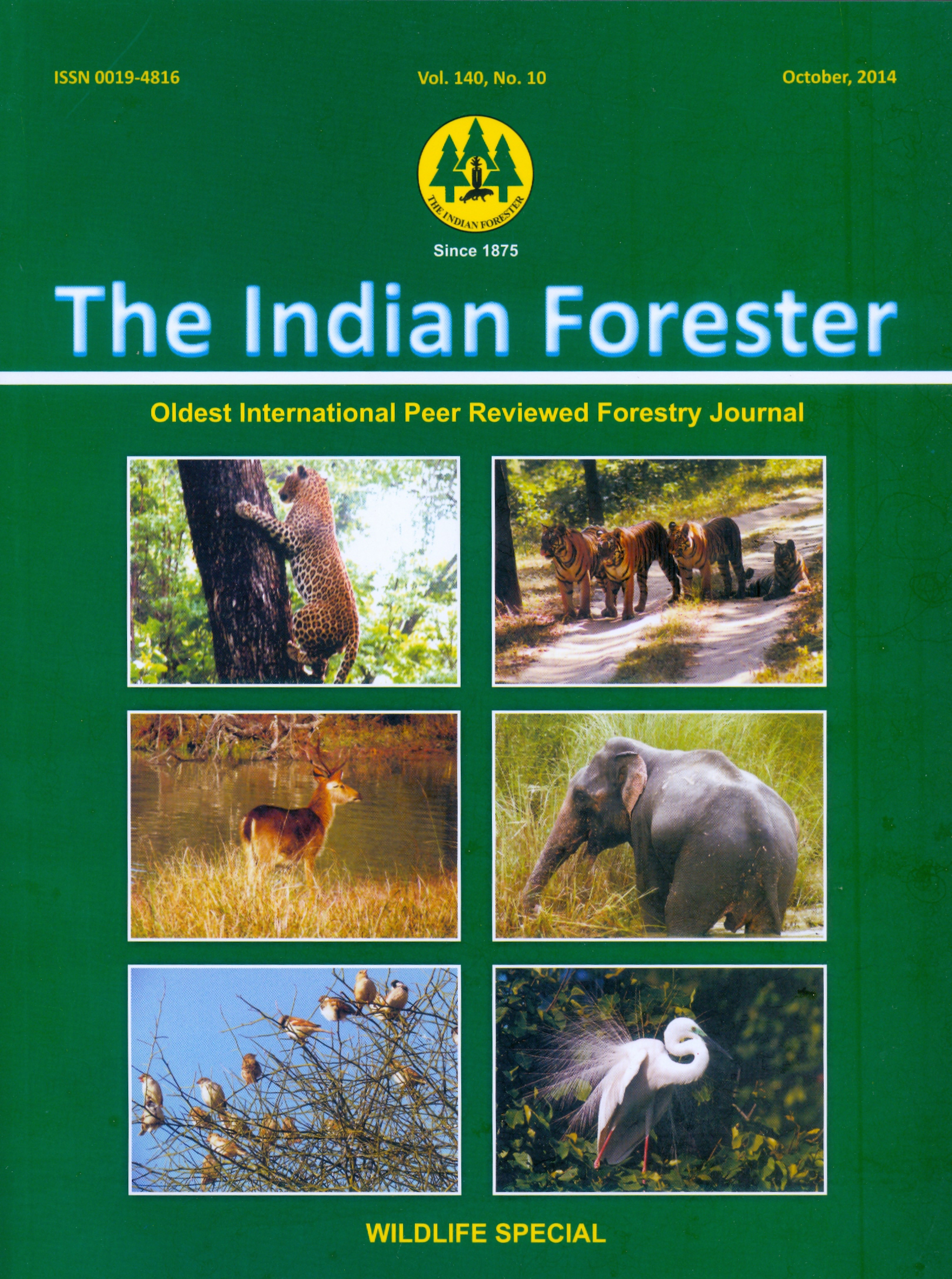Nesting of White-rumped Vulture (gyps Bengalensis,) in the Segur Plateau of the Nilgiri North forest Division, Tamilnadu, India
DOI:
https://doi.org/10.36808/if/2014/v140i10/53493Keywords:
White Rumped Vulture, Gyps Bengalensis, Nilgiri, NestingAbstract
Breeding sites of critically endangered white- rumped vultures (Gyps bengalensis) were studied in the Segur plateau of Nilgiris from August 2011 to August 2012. Both direct survey on foot and questionnaire survey were conducted with local inhabitants in and around the study sites. In total, 68 nests of white-rumped vulture were observed in two different locations namely Jagulikadavu and Siriyur. All the nests were recorded on two woody species namely Terminalia arjuna (66 nest) and Spondias mangifera (2 nest). The nests were recorded at a height of 18-36 mts from the ground level. Nest materials such as twigs, dry leaves, grass, thermocol and even polythene covers were observed.References
Poharka A., Anuradha Reddy P., Gadge V.A., Kolte S., Kurkure N. and Shivaji S. (2009). Is malaria the cause for decline in the wild population ofhe Indian White-backed vulture (Gyps bengalensis), Current Science, 96( 4): 553-558.
Ali S. and Riple S.R. (1987). Handbook of Birds of the birds of India and Pakistan, Oxford University press, New Delhi, Pp.76.
Chhangani A.K. and Mohnot S.M.(2004). Is Diclofenac the only cause of vulture decline. Current Science, 87(11): 1496-1497.
Chhangani A.K.( 2005). Population ecology of vultures in the western Rajasthan, India. Indian Forester, 131(10): 1373-1382
Chhangani A.K.( 2007). Sightings and nesting sites of Red-headed Vulture, Sarcogyps calvus in Rajasthan, India, Indian Birds, 3(6): 218-211.
Chhangani A.K.( 2004). Status of a breeding population of long-billed vulture (Gyps indicus) in and around Jodhpur (Rajasthan), India.Vulture News, 50: 15-22.
Chhangani A.K.(2009). Status of Vulture Population in Rajasthan, India. Indian Forester, 135(2): 239-251.
Galushin V.M. (1971). A huge urban population of birds of prays in Delhi, India. Ibis, 113:522
Green R.E., Newton I., Shultz S., Cunningham A.A., Gilbert M., Pain D.J. and Prakash V. (2004). Diclofenac poisoning as a cause of vulture population declines across the Indian subcontinent. Journal of Applied Ecology, 41(5): 793–800
Green R.E., Taggart M.A., Senacha K.R., Raghavan B., Pain D.J. and Cuthbert R. (2007). Rate of decline of the oriental white-backed vulture population in India estimated from a survey of diclofenac residues in carcasses of ungulates. PLoS One, 2(8): 686
IUCN (2004). 2004 IUCN Red List of Threatened Species. .
Naoroji R. (2006). Birds of Prey of the Indian subcontinent. Om book international.Pp:220-288
Oaks J.L., Gilbert M., Virani M.Z., Watson R.T., Meteyer C.U., Rideout B.A., Shivaprasad H.L., Ahmed S., Chaudhry M.J.I., Arshad M.,
Mahmood S., Ali A. and Khan A.A. (2004). Diclofenac residues as the cause of vulture population decline in Pakistan. Nature, 427:630-633.
Pain D.J., Cunningham A.A., Donald P.F., Duckworth J.W., Houston D.C., Katzner T., Parry-Jones J., Poole C., Prakash V., Round P. and Timmins R. (2003). Causes and effects of temporospatial declines of Gyps vultures in Asia. Conservation Biology, 17(3): 661-671
Prakash V. (1999), Status of vultures in Keoladeo National Park Bharatpur Rajasthan with special reference to population crash in Gyps species. J. Bombay Nat. Hist. Soc., 3: 365-378.
Prakash V. (2001), Status and distribution of vultures in India with special reference to the population crash in GYPS species Pp: 4-6 (Katzner T. and Parry-Jones J. eds) In: Reports from the workshop on Indian gyps vultures, Eurasian Congress on raptors sezilla). Spain Biological Donana Raptor Research Foundation.
Prakash V., Pain D.J., Cunningham A.A., Donald P.F., Prakash Verma N., Gargi R., Sivakumar S. and Ramani A.R. (2003). Catastrophic collapse of Indian White Backed (Gyps bengalensis) and Long Billed (Gyps indicus) vultures population. Biological Conservation, 109(3):381-390
Prakash V., Green R.E., Pain D.J., Ranades P., Saravanan S., Prakash N., Venki A. and Cunningham A.A. (2007). Resent changes in population of resident gyps vultures in India .J Bombay Nat. Hist. Soc., 104:129-135.
Ramakrishnan B., Sivaganesan N. and Srivastava R.K. (1997). Human interference and their impact on elephant corridors of Sathyamangalam and Coimbatore forest divisions. Indian Forester, 20: 1-19
Ramakrishnan B., Ramasubramanian S., Saravanan M. and Arivazhagan C. (2010). Is Diclofenac the only culprit for declining population of GypsVultures in the Moyar Valley. Current Science, 99 (12): 1645-1646.
Ramakrishnan B., Ramasubramanian S. and Samson A. (2012). Occurrence of Red-headed vulture in Segur plateau, Tamil nadu. Current Science, 102 (6): 832
Roy A. and Shastri K. (2013).Impact of kite string injuries and temporal variation in types of injuries and illnesses of white-rumped vultures of central Gujarat, India. Journal of Threatened Taxa, 5(14): 4887–4892
Shah N., Qureshi Q. and Roy A. (2011). Report on micro-level monitoring of veterinary use of non-steroidal anti-inflammatory drugs (NSAID) painkiller use and its distribution around select vulture sites. Bombay Natural History Society: 1–36pp.
Shultz S., Baral H.S., Charman S., Cunningham A.A., Das D., Ghalsasi G.R., Goudar M.S., Green R.E., Jones A., Nighot P., Pain D.J. and Prakash V.(2004). Diclofenac poisoning is widespread in decline vulture populations across the Indian subcontinent. Proceedings of the Royal Society of London, 271(suppl. 6): 458–460
Subramanya S. and Naveein O.C. (2006). Breeding of Long-billed vulture Gyps indicus at Ramnagaram hills, Karnataka, India. Indian Birds, 2(2.): 32-34.
Sutherland W.J. and Green R.E. (2004). Habitat assessment. In: (Sutherland W.J., Newton I., and Green R.E. eds) Bird Ecology and Conservation: A Handbook of Techniques. Oxford: Oxford University Press, pp. 251–268.
Swarup D., Patra R.C., Prakash V., Cuthbert R., Das D., Avari P., Pain D.J., Green R.E., Sharma A.K., Saini M., Das D., and Taggart M. (2007). Safety of meloxicam to critically endangered Gyps vultures and other scavenging birds in India. Animal Conservation, 10(2): 192-198 GOI (2002). The Wild Life (Protection) Act, 1972 - as amended up to 2003. Vide Notification No. S.O. 1085(E) dated 30.09.2002.
Verner J., Morrison M.L. and Ralph C. J. (1986). Modeling habitat relationships of terrestrial vertebrates. University of Wisconsin Press, Madison, Wisconsin.
Downloads
Downloads
How to Cite
Issue
Section
License
Unless otherwise stated, copyright or similar rights in all materials presented on the site, including graphical images, are owned by Indian Forester.





